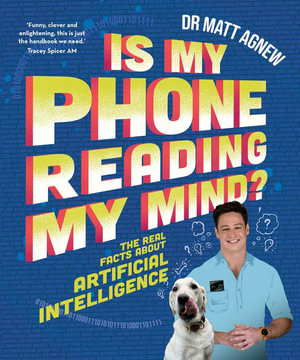Is my phone reading my mind? The real facts about artificial intelligence by Dr Matt Agnew

When Dr Matt asked ChatGPT for a list of titles for a book on artificial intelligence for ages 8-12 one of the serious titles it offered was AI Adventures: Discovering the Secrets of Smart Machines; a title that could easily suit the book. The success of the exercise tells us that we need to know more about how AI is changing the way we live and to understand something about how it works. The book uses cartoon illustrations and coloured pages and fonts with breakout boxes for examples and explanations to break up the text and allow for the inclusion of a lot of material. Starting with an explanation of artificial intelligence (AI) and the importance of algorithms, the building blocks of AI, it then goes on to look at where we find it in our everyday lives. That chapter swerves into a detailed mathematical explanation of how machine learning can predict whether a dog is more likely to be a labrador or chihuahua with calculations using averages, means, modes and medians. The coloured fonts on coloured pages sometimes make the numbers indistinct and a picture of a dalmatian in one of the illustrations doesn’t help the either/or exercise. There are good examples of AI use in our lives, like ordering something from Amazon and some history in a breakout box about the first time a computer beat a human at chess. The difficult concept of ethics dominates the next section where we learn that ethics are guidelines that help us understand if an action is right or wrong and that laws are more formal, stronger and carry a consequence. In explaining Kantian Ethics the example is stealing chocolate, which is against the law so it is a poor example, and in explaining Utilitarian Ethics the classic trolley problem clearly highlights the ethical dilemma but the Pokemon card example really should include the option to leave the card on the ground and do no harm; not including it just makes the question more confusing. These examples highlight the difficulties of the subject and should not discount the value of the book which covers a lot of ground; any attempt to increase understanding and raise awareness of how AI might be misused in deep fakes, echo chambers and through influencers must be commended. The author is well qualified to comment on the subject, the tone is friendly and the language accessible without condescension. Teachers might find some good examples to use in class discussions and parents should read this book with your children and then get them to explain AI to you.
Themes: Artificial Intelligence, Ethics, Algorithms.
Sue Speck